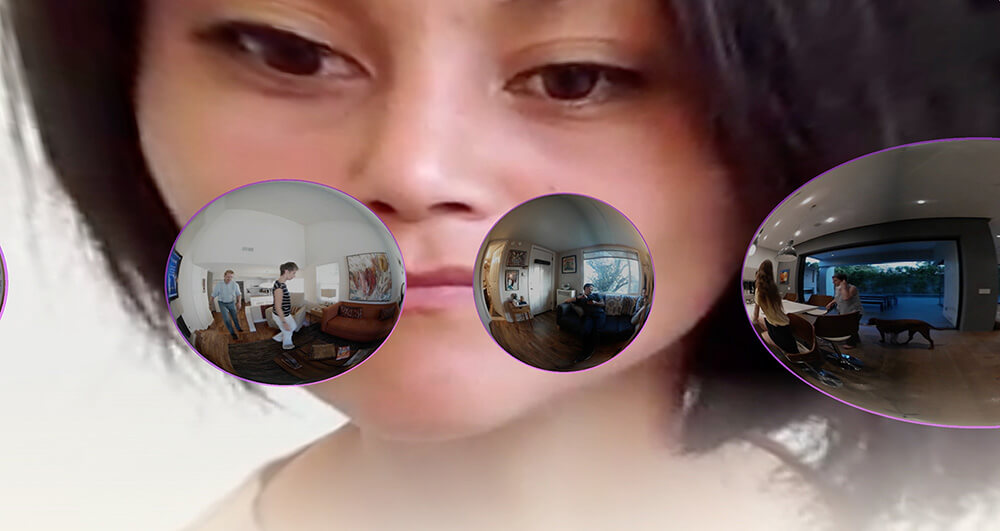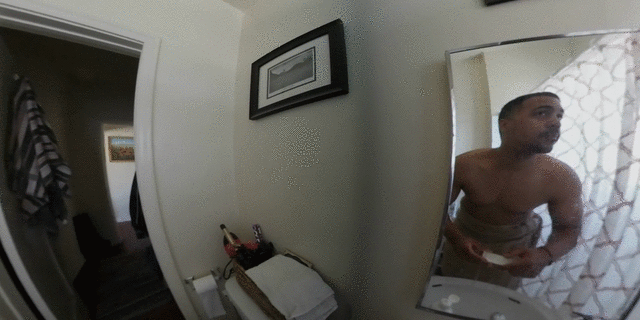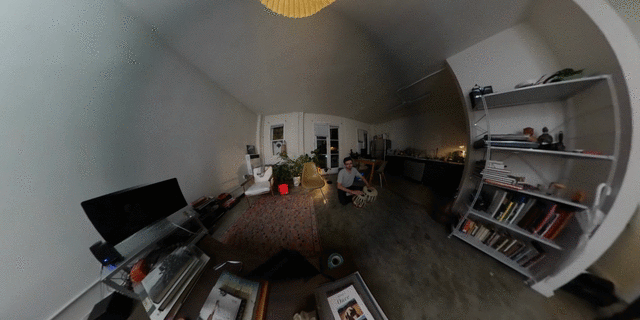Interview by Lidia Ratoi

Of all the things that drive people to technology and coding, the most common reason, I’ve come to learn, is their own humanity. Lauren McCarthy is a proper programmer. She is the creator of p5.js, an open-source programming language for learning creative expression through code online. She is the Co-Director of the Processing Foundation. She is an Assistant Professor at UCLA Design Media Arts. However, it is her exact quality of being a performance artist that makes her stand out the most.
Many years after Cabaret Voltaire, Mishima’s Suicide or Breathing in/ Breathing Out, one could consider that performance art is an extinct method. In an era in which we rarely even talk without the use of technology and in which AI is creating its own art, is there even any place for a human to be human? Yes. Lauren McCarthy proves this. She uses her own unique anthropoid particularities in order to create art.
Considering herself shy and declaring that she struggles with civil interaction, she pushes herself in uncomfortable situations that deal with the idea of socialising. In works such as Lauren, she becomes a human version of Amazon Alexa, setting up a system which enables her to watch over people’s homes and control those for them.
However, McCarthy manages to be one of the first and few people to prove that people are the augmented versions of machines and systems, and not the other way around – her possibility of understanding another as a person and empathising with their needs and desires makes her able to enhance the experience in their homes, in a way in which a coded system could never actAnother “life-meets-art-meets-tech” piece by McCarthy is Follower, in which the artist picks a volunteer and follows a said person for one day – however, the “followed” does not know when this day occurs. To be followed by her, one must answer two questions: Why do you want to be followed? Why should someone follow you?
In the end, the watched entity will receive a photo of themselves. It is a reverse-social media kind of action since, typically, one posts a photo and, independent of that, receives or loses followers. However, in this case, the loop between the follower and followed is reversed, the “content” being in the hands of the follower. It requires both a leap of faith, but also a chance of seeing yourself through the eyes of another, through something different than a virtual reaction.
It is uncommon to see a person with the skills of Lauren McCarthy out into the world. Or better said, into the wild. She takes the existence of the introverted coder from its digital existence, which rarely connects with the mundane reality, and places it amid the societal jungle.
Inspired by this oceanography of feelings which define us, she poses questions too rarely asked nowadays. One such question is “How would you like to feel?” which was something the users of the Changing Room installation had to answer. And according to the response, that feeling will be attempted to be recreated. When was the last time you thought about how would like to feel? When was the last time an artist acted like a real person?
When was the last time you interacted with an artist and not a software/installation/projection etc., of a said entity? When was the last time programming met actual reality and not just a utopian one? Lauren McCarthy made me ask myself these questions. On the downside, I realized I do not even have an answer, for they happened so long ago I have forgotten. On the plus side, she has given me an answer. Now.


Assistant Professor at UCLA Design Media Arts, Co-Director of the Processing Foundation, and an artist examining ‘social relationships in the midst of a surveillance, automation, and algorithmic living”: Could you please expand more on this? How and when did the interest in algorithms, creative coding, creative technology, and art come about?
I look at social rules and technological systems within which we understand ourselves and each other. Starting with social situations that feel most confusing, I use technology to create disruptions that reveal underlying expectations, assumptions, and systems of control. I begin with my own social anxiety and attempt to hack my way out.
In Social Turkers (2013), I went on a series of 30 dates with people I met on OkCupid. I discreetly streamed video of the date to the web, where I crowdsourced my dates by paying Mechanical Turk workers to watch and tell me what to say and do. Their directions were delivered in real-time, and I had to perform them immediately.
Realizing the limitations of this performance, I began to wonder whether machine learning could do a better job optimising our relationships. pplkpr (2014) was a quantified self-app that measured the biological effects of your relationships and auto-managed them for you. Appropriating startup language, pplkpr pushed beyond what seemed right, but left it up to the viewer to determine its true intention–satirical critique or techno-utopian fantasy realized?
For me it was both. I’m deeply critical and concerned about issues of surveillance and control. At the same time, I’m not interested in making work purely out of fear, so every project has a piece of optimism to it. What might it look like to build systems that helped us relate more easily?
Meeting new people is difficult for me; I’m shy and struggle with connection. I use my work to confront these fears, creating situations where I can have intimate interactions with strangers I wouldn’t otherwise be able to. In Follower (2016), I created an uber-like service that allows people to hire me to follow them for a day. I use a combination of a custom app broadcasting gps coordinates and eyesight to follow them physically all day, leaving them at the end with one photograph I take of them sometime during the day.
In LAUREN (2017), I attempt to become a human version of Amazon Alexa, a smart home intelligence in people’s own homes. Setting up a system of cameras, devices, and switches, I remotely watch over people and control their home for them, attempting to be better than an AI because I can understand them as a person and anticipate their needs and desires.
By making myself vulnerable in these works, I hope to inspire people to join me in taking risks together. I’m pushing on the limits of art and media forms. Rather than creating work that can be easily identified as art, I want to engage people in the context of their everyday lives. Too often, we’re asked to react to change immediately with a “like” or outrage. I don’t want to impose an opinion but give people a space to form their own. Space to engage with the tensions and feel out the future we want to live in.
You are the creator of p5.js, an open-source programming language for learning creative expression through code online; what makes p5.js so special that it has over 1.5 million users?
p5.js is an open-source JavaScript framework that makes creating visual media with code on the web accessible to anyone, especially those without traditional computer science backgrounds. p5.js enables users to quickly prototype interactive applications, data visualizations, and narrative experiences and share them easily on the web. It uses a metaphor of a sketchbook to make sketching with code as intuitive as sketching in a designer’s notebook.
Like making a mark on paper, a single line of code puts a circle on the screen, another changes its colour, and a third make it animate. p5.js has over 1.5 million users, is taught in K-12 through universities worldwide, and is used by hobbyists and professionals alike.
p5.js is a project that emphasizes inclusivity and access in its community of users and contributors. Historically, there has been a lack of representation of women and people of colour in both the arts and in technology, and too often efforts to remedy come as afterthoughts. By contrast, p5.js holds diversity and inclusion as core values upon which the software is built. It attempts to model what an open software and artistic project could look like by gaining strength through the range of ideas and opinions from its contributors.
Through the clear community statement, foreign language translation projects, making the software completely screen-reader accessible for users with visual impairments, and the outreach efforts lowering barriers to entry for women, people of colour, and people with disabilities as both users and contributors to the tool, the p5.js community aims to see our values in action.
Key ideas of our community are: (1) being explicit about our values of diversity, inclusion, and access and carrying it through every event, interaction, and line of code written, (2) valuing all types of contributions equally, whether it’s beginners or experts, writing, teaching, code, documentation, outreach, graphic design, or anything else, (3) prioritizing documentation as the key to entry and lifeblood of the project, and (4) constantly asking “who doesn’t feel welcome here, and how can we change that?” and following up, regardless of complexity.
You are exhibiting at two of the most important exhibitions focused on A.I. taking place this year. One is ‘Entangled Realities’ at HeK in Basel (Switzerland), and the second one is ‘AI: More Than Human’ at the Barbican Center in London; Did you create a new body of work for these two massive exhibitions?
For the past couple years, I have been developing a series of works around questions of AI, smart environments, and data in intimate social spaces. 24h HOST is a performance consisting of a small party that lasts for 24 hours, driven by software that automates the event, embodied in human HOST. Guests book a time in advance to enter the party.
Every five minutes throughout the 24 hours, a new guest will arrive and one will depart. Upon arriving, the guest enters a small structure that represents my home as the party HOST. From there, it is a scenario similar to a small cocktail party at home, but each aspect is somehow automated by software. As the HOST, I serve as the emotional interface to the AI, enacting directions with a human touch. I don’t want to say too much more than that, so as to leave some surprise for guests.
In LAUREN, I attempt to become a human version of Amazon Alexa, a smart home intelligence for people in their own homes. The performance lasts several days. It begins with an installation of a series of custom-designed networked smart devices (including cameras, microphones, switches, door locks, faucets, and other electronic devices). I then remotely watch over the person 24/7 and control all aspects of their home.
I aim to be better than an AI because I can understand them as a person and anticipate their needs without their having to ask. In the face of the increasing replacement of humans by automated systems and artificial intelligence, I reclaim the position as an omniscient watcher and controller of the home. I ask how feelings around surveillance, privacy, and intimacy shift when the viewer on the end of the system is known.
SOMEONE unfolds both in a gallery and in multiple private homes simultaneously. Visitors to the gallery are invited to step in as the human smart home intelligence. Four participants’ homes have been installed with custom-designed smart devices, including cameras, microphones, lights, and outlets.
When the homes are “on”, visitors can watch over them and remotely control their networked devices from this command center. They may hear smart home occupants call out for “Someone”—prompting you to step in as their home automation assistant and respond to their needs.
My most recent work is called Waking Agents. In the age of smart everything, we are sold technology for every aspect of our lives, promising to deliver us to utilitarian utopia. Even the personal space of sleep is invaded by smart pillows, technology-augmented pillows that play music, track sleep, and wake you up. In this installation, visitors are invited to lay down and nap with a smart pillow, attended to by its embedded intelligence. The intelligence serves as guide, companion, and caretaker while the user drifts between awareness and unconsciousness.
I’ll be showing a version of LAUREN at the Barbican Centre exhibition, as well as a new performance installation of the work designed for the gallery setting at HeK Basel.
AI is transforming society, and the creative application of AI is opening new possibilities in artistic creation; how do you think new inventions (machine learning, Google Magenta) are impacting the landscape of art creation (from inception to production)? Do you think AI-generated art is going to change the paradigms of art?
There’s a long history of artists working with new technologies among their tools and questioning the limitations and assumptions built into them. With data-driven tools like ML, we’re experiencing the possibility of generating a future seeded with the past. So how do we get to outcomes that are have not already been lived? I believe AI/ML provides a chance for reckoning.
It becomes clear that there is bias in our datasets and when this gets encoded in ML systems, we can no longer deny the bias exists. The difficulty is how to recognize and dismantle these with learning systems as our tools. If we can find ways to, we have a chance at uncovering new artistic possibilities within a more just world. I think it can be seen as a creative challenge. How to push the visual, aesthetic, and conceptual possibilities beyond what we currently think is possible technically?
What directions do you see taking your work into?
While I often use myself in my performance-based works, I’ve recently begun working with other performers. I’ve really enjoyed the ways they bring their own perspectives to each work and challenge the assumptions at the core of each. I’d like to continue to develop this practice and create works that are able to involve more people. In terms of subject matter, my practice tracks my life.
The smart home AI series grew out of the anxiety of marrying and moving in with a partner and wondering what it means to have a foreign presence cohabitate in my home. So I believe the next series of works will grow out of a question I’ve been grappling with more lately, reproduction.
What is your chief enemy of creativity?
Busyness. Not having enough time and space to let my mind wander into strange places and take root there for a while. I moved from NYC to LA a few years ago and I have really appreciated the space here. Not just physically, but mentally and emotionally, not being in such a crowded city means not talking to people about whatever I’m working on so constantly. It lets projects grow in more unexpected directions.
You couldn’t live without…
Mornings.






